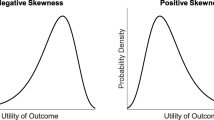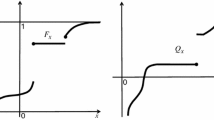Abstract
This article extends the classic RothschildNStiglitz characterization of comparative risk ("increasing risk") in two directions. By adopting a more general definition of "mean preserving spread" (MPS), it provides a direct construction of a sequence of MPS's linking any pair of distributions that are ranked in terms of comparative risk. It also provides a direct, explicit construction of a zero-conditional-mean "noise" variable for any such pair of distributions. Both results are extended to the case of second order stochastic dominance.
Similar content being viewed by others
References
Bawa, Vijay. (1982). “Stochastic Dominance: A Research Bibliography,” Management Science 28, 698–712.
Billingsley, Patrick. (1968). Convergence of Probability Measures. New York: John Wiley and Sons.
Billingsley, Patrick. (1986). Probability and Measure (2nd ed.). New York: John Wiley and Sons.
Blackwell, David. (1951). “Comparison of Experiments.” In Jerzy Neyman (ed.), Proceedings of the Second Berkeley Symposium on Mathematical Statistics and Probability. Berkeley: University of California Press.
Blackwell, David. (1953). “Equivalent Comparisons of Experiments.” Annals of Mathematical Statistics 24, 265–272.
Choquet, G. (1969). Lectures on Analysis (J. Marsden, T. Lance, and S. Gelbert, eds.). New York: W. A. Benjamin.
Feller, William. (1971). An Introduction to Probability Theory and Its Applications (Vol. II, 2nd ed.). New York: John Wiley and Sons.
Fishburn, Peter, and Raymond Vickson. (1978). “Theoretical Foundations of Stochastic Dominance.” In G. A. Whitmore and M. Chapman Findlay (eds.), Stochastic Dominance: An Approach to Decision Making Under Risk. Lexington, MA: Heath.
Hadar, Josef, and William Russell. (1969). “Rules for Ordering Uncertain Prospects,” American Economic Review 59, 25–34.
Hadar, Josef, and Tae Kun Seo. (1990). “The Effects of Shifts in a Return Distribution on Optimal Portfolios,” International Economic Review 31, 721–736.
Hanoch, Giora, and Haim Levy. (1969). “The Efficiency Analysis of Choices Involving Risk,” Review of Economic Studies 36, 335–346.
Hardy, G. H., John Littlewood, and Gyorgy Pólya. (1929). “Some Simple Inequalities Satisfied by Convex Functions,” Messenger of Mathematics 58, 145–152.
Hardy, G. H., J. Littlewood, and G. Pólya. (1934). Inequalities. Cambridge, England: Cambridge University Press.
Kaas, R., A. E. van Heerwaarden, and M. J. Goovaerts. (1994). Ordering of Actuarial Risks. Brussels: Education Series 1, CAIRE. (Second edition, forthcoming).
Klambauer, Gabriel. (1973). Real Analysis. New York: American Elsevier.
Kolmogorov, Andrei, and Sergei Fomin. (1970). Introductory Real Analysis. New York: Dover Publications. (English translation by Richard A. Silverman.)
Landsberger, Michael, and Isaac Meilijson. (1990). “A Tale of Two Tales: An Alternative Characterization of Increasing Risk,” Journal of Risk and Uncertainty 3, 65–82.
Levy, Haim. (1992). “Stochastic Dominance and Expected Utility: Survey and Analysis,” Management Science 38, 555–593.
Müller, Alfred. (1996). “Ordering of Risks: A Comparative Study via Stop-Loss Transforms,” Insurance: Mathematics and Economics 17, 215–222.
Pratt, J. (1990). “From Dominance to Noise in One Step,” manuscript, Harvard University. Cambridge, MA.
Quirk, James, and Rubin Saposnik. (1962). “Admissibility and Measurable Utility Functions,” Review of Economic Studies 29, 140–146.
Rockafellar, Ralph. (1970). Convex Analysis. Princeton, NJ: Princeton University Press.
Rothschild, Michael, and Joseph Stiglitz. (1970). “Increasing Risk: I. A Definition,” Journal of Economic Theory 2, 225–243.
Rothschild, Michael, and Joseph Stiglitz. (1971). “Increasing Risk: II. Its Economic Consequences,” Journal of Economic Theory 3, 66–84.
Rothschild, Michael, and Joseph Stiglitz. (1972). “Addendum to ‘Increasing Risk: I. A Definition’,” Journal of Economic Theory 5, 306.
Scarsini, Marco. (1994). “Comparing Risk and Risk Aversion.” In Moshe Shaked and J. George Shanthikumar (eds.), Stochastic Orders and Their Applications. San Diego: Academic Press.
Schmeidler, David. (1979). “A Bibliographical Note on a Theorem of Hardy, Littlewood, and Pólya,” Journal of Economic Theory 20, 125–128.
Sherman, S. (1951). “On a Theorem of Hardy, Littlewood, Pólya, and Blackwell,” Proceedings of the National Academy of Sciences 37, 826–831; “Errata,” Proc. Nat. Ac. Sci.38, 382.
Strassen, V. (1965). “The Existence of Probability Measures with Given Marginals,” Annals of Mathematical Statistics 36, 423–439.
Author information
Authors and Affiliations
Rights and permissions
About this article
Cite this article
MACHINA, M., PRATT, J. Increasing Risk: Some Direct Constructions. Journal of Risk and Uncertainty 14, 103–127 (1997). https://doi.org/10.1023/A:1007719626543
Issue Date:
DOI: https://doi.org/10.1023/A:1007719626543




